Par Jonathan Duffy, Arctic Meta
Iceland is a country filled with some incredible sights and fascinating contrasts. It’s called the land of fire and ice for a reason. It is a place where glacial mountains, volcanoes and lush green plains all mix together to create a landscape that belongs in the pages of a fantasy novel.
Many people who plan a trip to Iceland wonder if there is a specific place that is the best area to visit, and honestly, there isn’t. The whole country is filled with incredible sights and attractions. The best question to ask when preparing to visit Iceland is, ‘What do you want to get out of your experience?’
Many people who visit Iceland land in the capital, Reykjavík, and spend a significant amount of time travelling the South Coast, and this is a great idea. The south has a lot of incredible attractions available in a relatively short expanse of space, but there are other places just as worthy of your attention.
One place you really should add to your Icelandic bucket list is Ouest de l'Islande. It’s filled with unique attractions, unrivalled beauty and fascinating history. So why should you visit West Iceland? How long should you plan to travel there? What are the best things to see and do? Read on to find out more.
Why Should You Visit West Iceland?
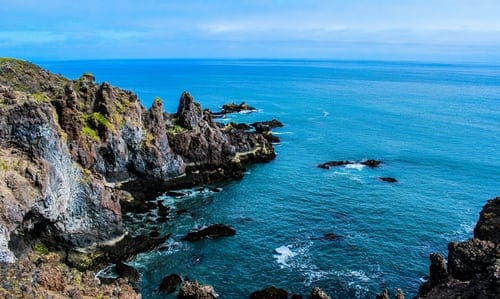
Many people travel to Iceland because they want to experience the vast array of natural landscapes the country has to offer. What a lot of people don’t realise is that a large portion of the west is often referred to as Iceland in miniature because it contains a lot of the natural variety in a relatively small space.
Visitors to the west will be able to see incredible seascapes, mountain cliffs, volcanic regions, glaciers, waterfalls, and so much more. Probably one of the best things about the west is that it isn’t very far from the capital region, meaning that it’s perfect for those who want to get the most out of their stay but only have a short space of time.
How Long Do You Need to Spend in West Iceland?

As stated above, the West of Iceland offers a great solution to travellers who want to see a lot in a short time frame, but that doesn’t mean it’s only worth visiting the west for a few days.
The truth is that the west of Iceland is a versatile region that has a lot to offer travellers. Visitors could take in the sights and sounds of the west in a long weekend by sticking to the area near the Snæfellsnes Peninsula. They could also, weather permitting, spend a week or two exploring every single corner of the magnificent Westfjords.
Instead of asking how much time you need to spend in the west, it’s more valuable to ask how much time you have.
What Are the Best Things to Do in West Iceland?
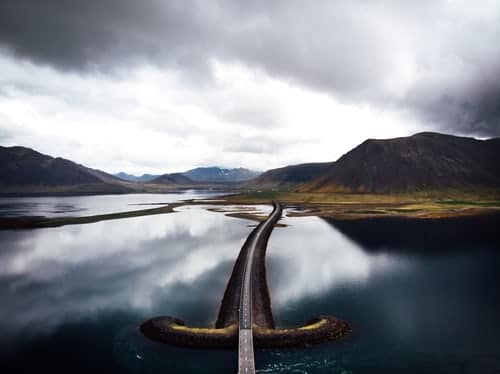
If you’re planning a visit to the West of Iceland, it’s a good idea to decide what you want to see and do before you get here. The possibilities are endless but to help you plan your trip, below are a few of the top activities and attractions on offer.
Deildartunguhver and Krauma Spa
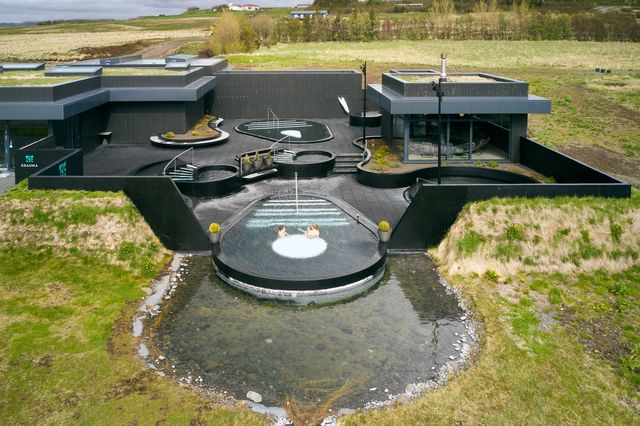
Iceland is known for being home to hot springs. The volcanic nature of this country has created many relaxing natural hot pools all over the beautiful landscape. The largest and most powerful hot spring in Europe is called Deildartunguhver, and it is situated in the west of Iceland, not far from the historical village of Reykholt.
Deildartunguhver pumps an impressive 180 litres of steaming hot water every second of the day and is primarily used to heat nearby towns and greenhouses. It’s worth visiting this impressive body of geothermally heated water.
Hanging out in a hot pool is as Icelandic as Björk. Geothermal water is so readily available in Iceland that even the public pools of the country use it. If you want to mix a bit of a local custom with some well-deserved pampering, you should visit the Krauma Spa.
Krauma takes the Icelandic tradition of relaxing in a hot pool and turns it up a notch to give visitors an experience they will never forget. The site contains naturally heated pools, soothing saunas and relaxation spaces that are perfect for letting the stresses of the world melt away while you soak in the midst of the incredible vistas of West Iceland.
The Village of Reykholt
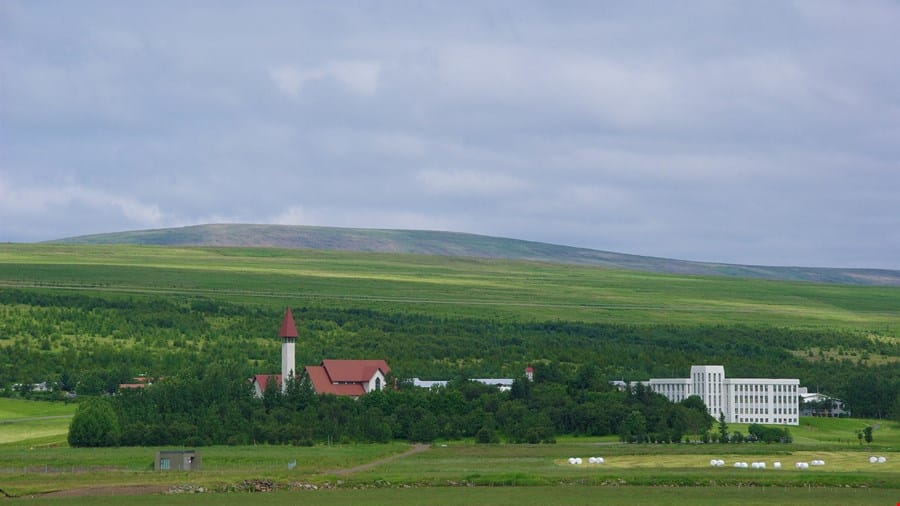
This quaint village is one of the most important historical sites in Iceland. Reykholt was once home to an Icelandic man named Snorri Sturluson. Snorri lived from 1206 to 1241, and during his life, he wrote ‘The Prose Edda’, which today is considered to be the most complete and extensive source of information on Norse Mythology. His work is also believed to be one of the most important and influential pieces of writing in Scandinavian history.
In the heart of Reykholt, you can find a museum, cultural and mediaeval centre all rolled into one. This place is called Snorrastofa (Snorri’s Place). Reykholt is also home to a beautiful Swiss-chalet style church with an exterior that has been adorned with neoclassical features.
Langjökull – Iceland’s second-largest glacier
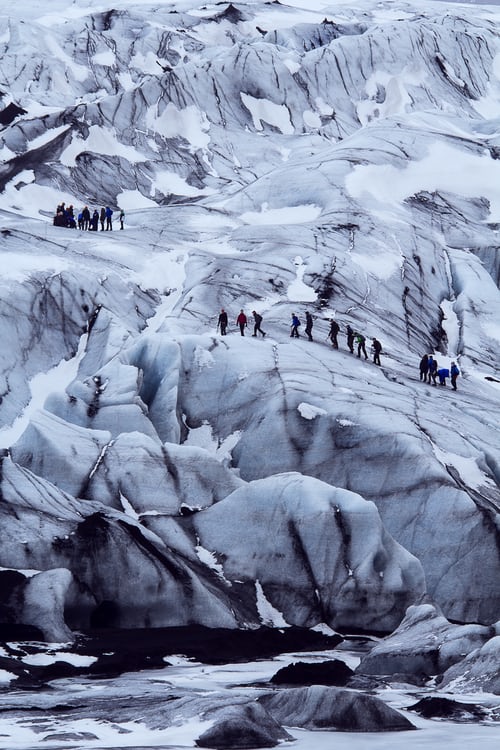
There are many glaciers in Iceland, and one of the most popular ones lies in the country’s west. Langjökull is a popular destination for locals who love to ski and hike. It’s the second-largest glacier in the country after Vatnajökull (which is also the largest glacier in Europe).
Langjökull’s name means ‘The Long Glacier’, and it’s easy to see why. It covers an impressive 950 square kilometres (367 square miles) of land, and its large, flat expanses of ice make it an ideal playground for snowmobiling.
Underneath Langjökull, there is a large network of underground man-made ice caves that will transport visitors to a wintery, shimmering wonderland unlike any other on the planet. West Iceland also has a recently discovered natural ice cave to explore at Langökull.
Snæfellsjökull National Park and Glacier
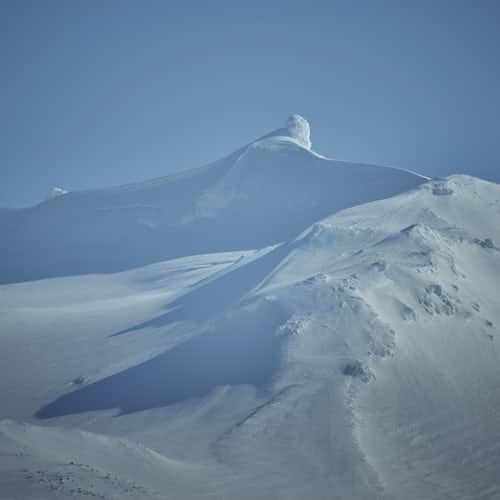
Another resident of Iceland’s west is one of the most famous landmarks in the country. Snæfellsjökull is both a stratovolcano and a glacier. This impressive natural formation is over 700,000 years old. As far as land masses go, Iceland is basically a toddler. It wasn’t that long ago that it rose out of the sea as a result of intense volcanic eruptions. The western part of the country contains some of the oldest regions, and Snæfellsjökull is one of those.
Science fiction fans will recognise the name because it was the setting for the beginning of the Jules Verne epic, ‘Journey to the Centre of the Earth.’
Snæfellsjökull and the surrounding area have captivated and inspired locals and tourists for years, and the volcano has historically been considered to be a place of great power.
Hraunfossar and Barnafoss
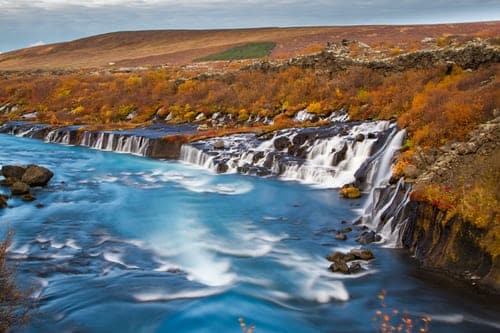
There are so many impressive waterfalls to see in Iceland (more than 10,000) that you could literally plan an entire vacation around seeing only them. There are two falls in Iceland’s west that should definitely be added to your ‘must-see’ list if you’re coming this way.
Hraunfossar (Lava Falls) is a collection of small waterfalls that have merged over time to create a magnificent curtain that gracefully drops from the side of a rock face into the river below.
Not far from Hraunfossar is Barnafoss (the children’s waterfall). Barnafoss is a fast-flowing waterfall that twists and turns as it creates rapids. The waterfall’s name is believed to come from an old folk tale about two boys who attempted to cross the treacherous waters only to never be heard from again.
The sounds of both Hraunfossar and Barnafoss are almost musical when they are juxtaposed against the almost silent backdrop of the expansive scenery of Iceland’s west.
Vatnshellir Cave
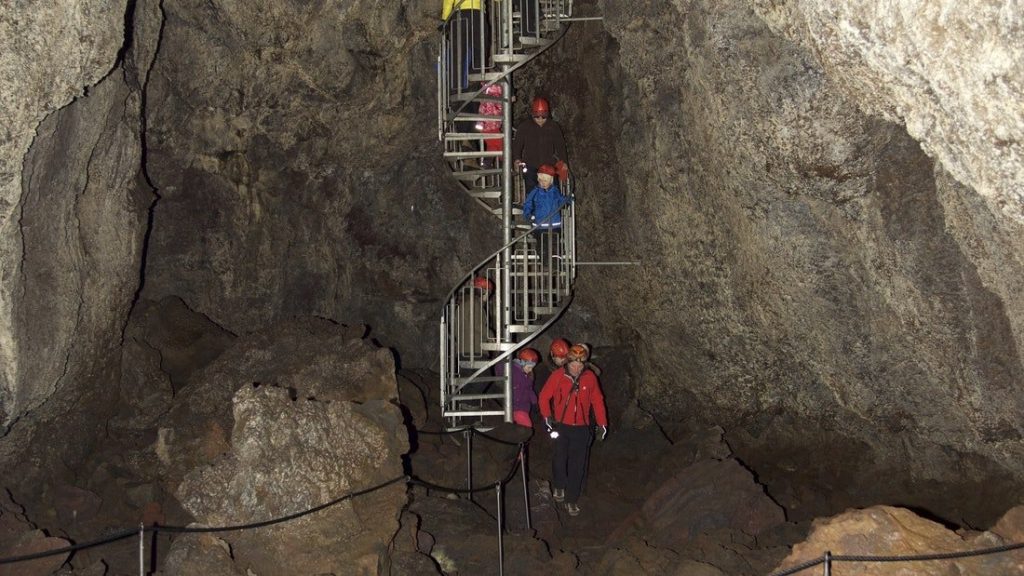
Vatnshellir is an 8,000-year-old cave that was formed as a result of lava rapidly moving through the landscape during a volcanic eruption. There are many guided tours of the cave all year round, and the cave itself has only been open to visitors since 2011.
While visiting Vatnshellir, a guide will take you through the cave, following the original lava flow that created it. The cave tunnel itself is about 200 metres in length and burrows 35 metres below the ground.
Visiting Vatnshellir is a great way to learn about how the beauty of Iceland was forged out of fire as you take in the impressive rock structures and natural colour scheme.
Háafell goat farm
Iceland is famously known for having more sheep than people and the Icelandic people, and they even have their own special breed of horse. The people of Iceland have had a very intrinsic relationship with both of these animals for a long time, but there is also an Icelandic goat.
The Icelandic goat is also known as the ‘Settlement Goat’, and this breed can be dated back to the original Nordic settlers of Iceland. Much like the Icelandic horse, this species of goat only exists in Iceland and has almost become extinct twice. The numbers dwindled dramatically but recovered after the Second World War, and then after that, they started to decline again.
The Icelandic goat is the only domestic farm animal that receives assistance from the Icelandic government to ensure its survival. Háafell (pronounced How-A-Fell) Goat Farm is an initiative to try to help keep the numbers of this species up.
The site is very typical of an idyllic Icelandic farm. It’s incredibly welcoming and warm. The goats themselves love attention, and some of them have even been featured in TV shows and movies like Game of Thrones.
The farm also boasts a small shop with some incredible products made from goat milk like cheeses, ice cream and skincare products.
Steðji Micro Brewery
During the prohibition era of the 1920s, the Icelandic government banned the sale of beer, and although alcohol gradually came back as a legal product, beer remained illegal until March 1st 1989.
Since then, the Icelandic people have rejoiced in their love of beer. In fact, beer is the most consumed alcoholic beverage in the country, with almost 80% of domestic alcohol sales in 2020 being for beer.
In the past two decades, many micro breweries have popped up around the country, and they have produced some of the best brews around. Experts often agree that fresh water is one of the most defining ingredients in a good beer, and Iceland has an abundance of it straight from glaciers.
Steðji is one of the most famous microbreweries in the country, and a visit here will allow visitors to soak up the farmhouse atmosphere while learning about how the brews are made. The most important part of a visit here is, of course, the tasting.
Kirkjufell Mountain
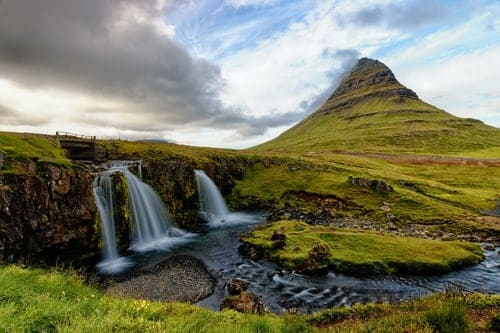
Fans of the HBO show Game of Thrones would instantly recognise Kirkjufell Mountain because in the show it starred as ‘The mountain shaped like an arrowhead.’ Even if you’re not a fan of this show, you have probably seen this mountain because it is one of the most photographed natural landmarks in the country.
Its unique shape seems to look like a traffic cone or a witch’s hat, and it looks equally beautiful in fuzzy green during summer or blanketed in thick white snow in winter.
It sits 463 metres above sea level and, at times, looks perfectly symmetrical. This area is also home to an abundance of bird life. Kirjufell is a great place to stop, ponder and take in the otherworldly beauty the west of Iceland has to offer.
Stykkishólmur
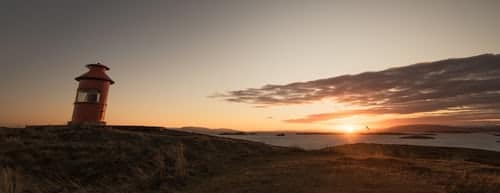
Stykkishólmur is one of the largest towns on the Snæfellsnes Peninsula, even though it only has a permanent population of just over 1000 people. In history, this town was primarily a centre for trade and fishing, and this is still somewhat prevalent today.
Stykkishólmur is also the starting point for the famous Baldur Ferry which travels to the Westman Islands. The town is a great example of quintessential harbour town life in Iceland, and visitors could spend a lot of time exploring the town and marvelling at the typical Icelandic houses, clad in corrugated steel and painted in sometimes bright colours.
Stkkishólmur also stood in for the Greenlandic village of Nuuk in the 2013 film, The Secret Life of Walter Mitty.
Breiðafjörður Bay
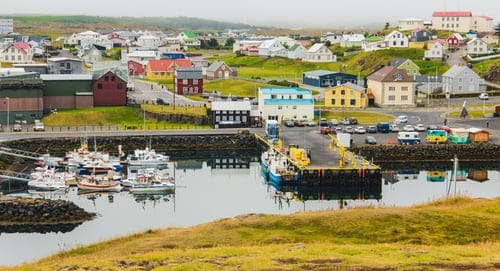
Breiðafjörður Bay is an attraction that nature lovers simply can’t miss in the West of Iceland. The bay itself comprises around 3, 000 small islands that are a safe haven for many birds including, the common shag, the white-tailed eagle and, of course, the Atlantic puffin.
Breiðafjörður is also one of the many UNESCO World Heritage Sites in Iceland.
Where Can You Eat in West Iceland?
There are many restaurants to choose from in the West of Iceland, depending on your tastes and dietary requirements. It is good to remember that making a reservation ahead of time is always advisable because some of the local food haunts can be insanely popular.
If you would like to save a bit of money, it can be a great idea to visit a local grocery store to stock up on important items, snacks and non-perishables to tie you over as you travel around this vast part of Iceland.
Stay at the Panorama Glass Lodge in West Iceland (soon)
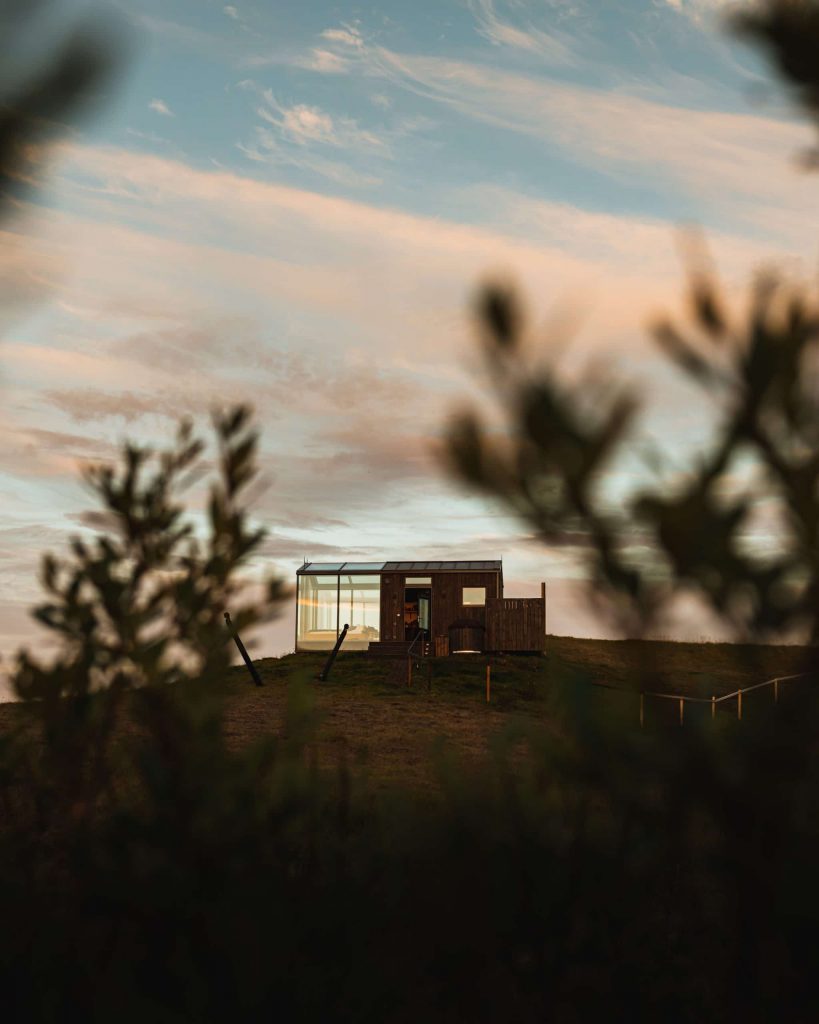
There are loads of accommodation options when visiting Iceland, depending on your individual needs and budget, but few are as unique as the Panorama Glass Lodge.
The Panorama Glass Lodge combines the magic of the Icelandic countryside and brings it inside, providing luxury accommodation that still has a high level of privacy.
Every luxury Panorama Glass Lodge capitalises on the surrounding views with large glass windows that give you a permanent glimpse of nature but shield you from the elements.
Panorama has been a favourite accommodation option for visitors to Iceland’s South Coast, but very soon, it will also be an option for those heading west, with three new cabins opening just across the bay from the town of Borgarnes.
Conclusion
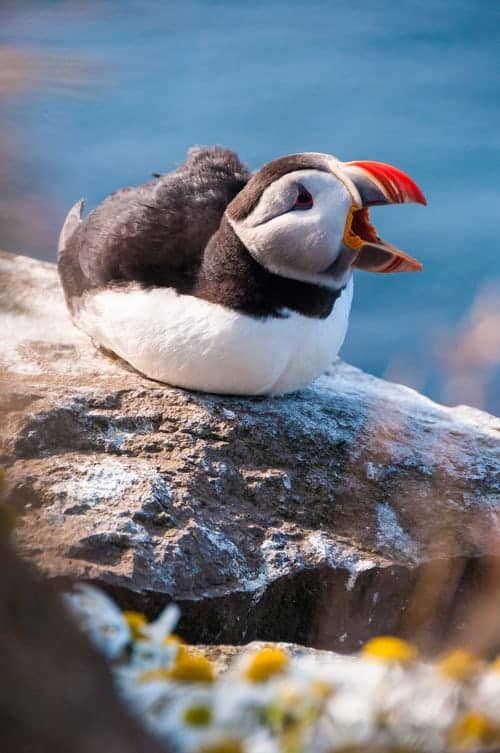
There are many incredible locations and regions to visit when coming to Iceland, but few can match the variety, history and charm of the west. So come check it out; you won’t be disappointed.
